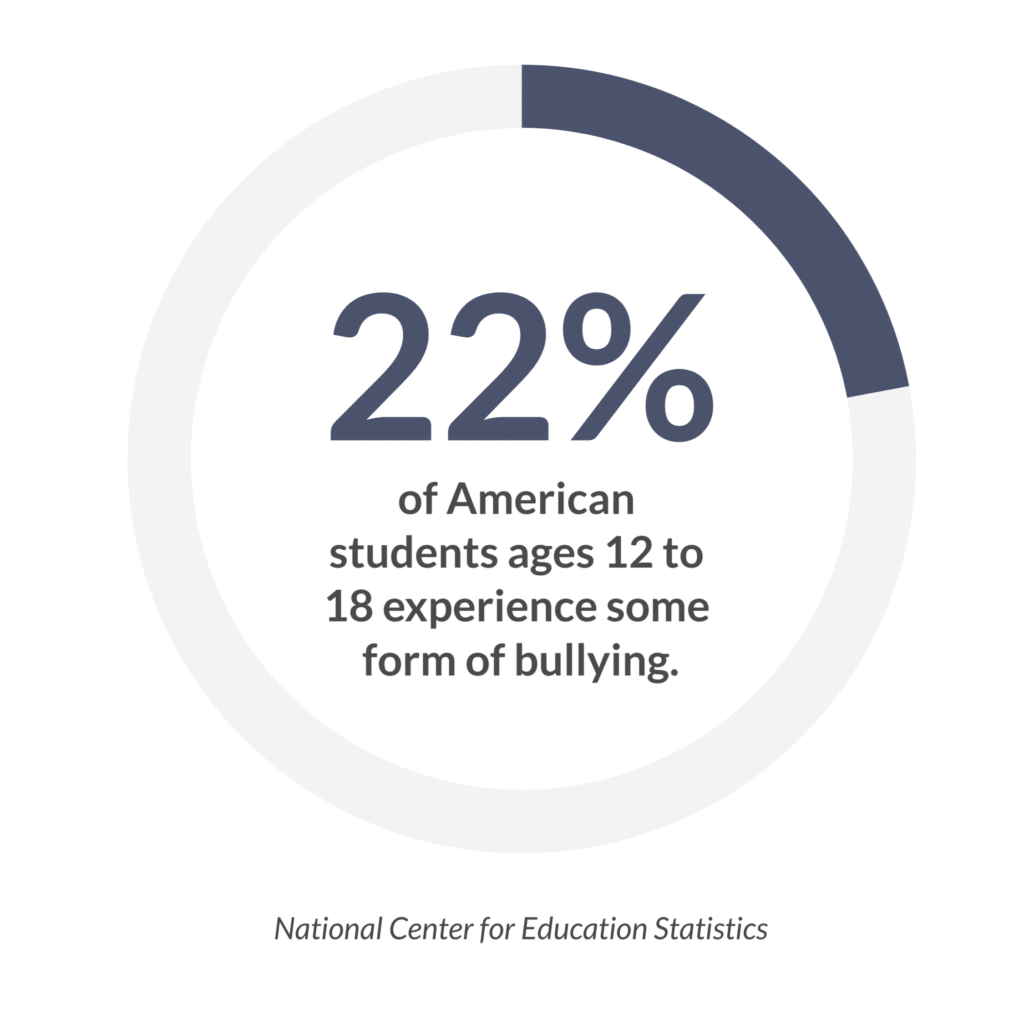By Clint Fletcher
For kids and teens everywhere, school means homework, car pool, school lunches, football games — and bullying. The problem has gained more attention in recent years, but a significant portion of children and teens are still affected despite the increased bullying awareness. Consequently, there should be more critical consequences of bullying.

According to the National Center for Education Statistics, about 22% of American students ages 12 to 18 experience some form of bullying. Additionally, more than 1 in 6 high school students reported being cyberbullied in the last year, says the Centers for Disease Control and Prevention (CDC).
Bullying can be experienced physically, verbally, relationally, and even electronically, and it isn’t always easy for parents to spot. You may think of bullying as just a difficult, inevitable part of everyday life. But just because it has been around for generations and occurs in a variety of environments doesn’t mean bullying has to be tolerated. There are actually many long-term adverse effects of bullying, so parents and kids should address the problem together in a healthy, positive way.
By taking steps to address bullying as it happens, you can help prevent difficult mental health conditions from developing in bullying victims, as well as in bullies themselves. And combating bullying through implementing anti-bullying strategies as a community can promote healthy awareness and even prevent bullying before it starts.
Recognizing Bullying
The causes of bullying can be incredibly layered and complex, but they all share a similar theme: Bullying is almost always behavior that’s learned in response to stresses in the bully’s world. While most bullies can give the appearance of having confidence, the chances are strong that whatever they’re doing is driven by their fears, insecurities, and issues.
The American Society for the Positive Care of Children shares the following signs that a child may be bullying others:
- Aggressiveness
- Physical or verbal fights
- Friends with other bullies
- Sent to the principal’s office
- Very competitive
- No responsibility for their actions
- Blame others for their problems
- Unexplained extra money
- Frequent detention
- New belongings
- Reputation or popularity concerns
Understanding the Types of Bullying
Creating a bully-free environment first starts with understanding the various types of bullying, so you can implement anti-bullying strategies to prevent it in the future. While bullying takes many shapes and forms, these are often the most common:
Physical Bullying
Usually thought of as school bullying, physical bullying takes place between someone who is bigger and stronger than the person being targeted, shares VerywellMind.com. It involves assaulting a person’s body or possessions, and can look like pushing, tripping, hitting, kicking, spitting, making rude hand gestures, or breaking someone’s belongings, according to StopBullying.gov.
Verbal Bullying
When you picture workplace bullying, it often falls under the verbal bullying category. Defined as spoken or written words to intimidate or insult others, verbal bullying can be a long-term source of stress or anxiety, explains VerywellMind.com. Examples of verbal bullying include teasing, inappropriate sexual comments, name-calling, and threats.
Social Bullying
Also known as relational bullying, social bullying occurs when someone hurts another’s reputation or relationships. StopBullying.gov shares social bullying examples such as spreading rumors, embarrassing someone in public, and telling others (usually children) not to be friends with someone.
Cyberbullying
Cyberbullying is any bullying that takes place on digital devices like cell phones, social media platforms, or online forums. It typically involves sending harmful or false content about someone, as well as private information meant to embarrass others, shares StopBullying.gov.
Creating a bully-free environment first starts with understanding the various types of bullying, so you can implement anti-bullying strategies to prevent it in the future.rn
The Impact of Bullying
We’ve established that bullying is still quite common in US schools, with roughly one in every 4.5 students saying they’ve been bullied. However, school bullying doesn’t just affect the one being picked on. StopBullying.gov research indicates more than 70% of young people have witnessed bullying in schools.
In one large study, roughly 49% of children in grades 4-12 reported being bullied at least once a month, and 40.6% of students reported involvement in bullying. Out of that group, 23.2% were bullied, while approximately 30% of the students surveyed admitted to bullying others.
Bullying can take many forms. Name-calling tops the list at 44.2%, followed by teasing at 43.3%, spreading rumors or lies at 36.3%, and physical pushing/shoving at 32.4%. The most troubling stat of all might be that only 20-30% of bullied students tell an adult what’s going on. It’s not surprising that most bullying occurs in school, on school grounds, and the school bus, with classrooms being the most common setting.
Mental Health and Bullying
It can be challenging for researchers to draw a direct line from bullying to adverse long-term effects. Still, there is a direct correlation between mental health and bullying. One study suggests children who are victims of bullying are more likely to develop anxiety and depression disorders. They also may be at higher risk for health problems like colds, headaches, stomachaches, and sleep problems, and more likely to take up smoking. Bullied kids may also be more prone to self-harm or have suicidal thoughts in adolescence.
In another five-decade study published by the American Journal of Psychiatry, the health outcomes of adults who were victims of bullying as kids were examined. British researchers discovered that those frequently bullied were more likely to have poor social, health, and economic outcomes in life decades later.
Psychological Bullying Effects
- Anxiety
- Depression or sadness
- Higher risk of physical illness
- Loneliness
- Changes in sleep
- Changes in eating patterns
- Decreased academic achievement
- Self-harm
- Suicidal thoughts
Bullying Prevention: How to Deal with a Bully
Learning how to deal with a bully can be challenging. Still, there are various ways to act more intelligently if you find yourself in these situations.
Most bullies know they don’t deserve your respect. They lose their power when you remain confident and don’t back down. Speak to a bully with a strong, confident, and courteous demeanor. Your confidence and self-assurance will typically win them over. Bullies control their victims by making them feel alone and powerless. Bullied people should maintain close connections with supportive friends to reclaim their power.
When you stand up to a bully, you want to clarify that you won’t be victimized. If you pose a challenge, you give the bully the sense of attention and power they’re seeking. Use simple, assertive, and unemotional language to ensure they don’t take advantage of you.
A bully’s ultimate goal is to get under your skin. You shouldn’t let your emotions get the best of you when you face a bully. Remain composed but set clear limits. Practicing your responses so you’re prepared if the situation arises again will allow you to respond swiftly while protecting your emotions and building resilience.
Bullying often starts in a mild form and worsens the more prolonged the bully has power over you. If the bully doesn’t think you’ll stand up for yourself or tell someone, the aggression will worsen. Therefore, it’s essential to act quickly and consistently in the face of a bully.
Striking while the iron is hot isn’t the case for dealing with a bully. It’s better to take a step back and not exchange in the heat of the moment. Solutions are often found when you have a cooler head. The situation might even sort itself out in the meantime.
Support for Bullying Victims

Being a bullying victim can feel isolating, discouraging, and lonely, but it’s important to remember that you or your loved one is not alone. Seeking support from your peers and community can bring encouragement, inclusion, and positive change. A study conducted among school children by The Journal of School Nursing showed how bullied victims (as well as their peers) can gain courage and strength by sharing their difficulties in support groups with other students and following up with authority figures like teachers and school nurses.
Because bullying and mental health are so intertwined, getting care for your own mental health as a victim is also a key component to healing that can prevent the development of long-term mental health conditions like PTSD, depression, or personality disorders. If you’re unsure where to get started, searching for mental health resources online can give you a wealth of helpful options, including those listed at the end of this article.
Seeking individual support from a professional therapist (or even a school counselor) can be a positive first step as well. Through therapy, you or your loved one can learn better coping skills, establish healthy communication techniques and boundaries, and increase your self-esteem and self-confidence.
Intervention Techniques: How to Proactively Approach Bullying
You know the facts now, but what can you do about bullying? It all comes down to communication. According to experts, kids first need to understand what bullying is, why it’s wrong, and why they should come forward to an adult when it occurs. After that, the line of communication needs to remain open between parents and children. Check in with your kids as often as you can. Listen, become familiar with their friends, and ask questions about school.
Check in with your kids as often as you can. Listen, become familiar with their friends, and ask questions about school.rn
Being prepared is critical. Strategize with your kids and develop a plan for how to deal with a bully if an adult isn’t near. Suggest they try to disarm the bully with humor, firmly tell them to stop, grab a safe friend or peer nearby, or simply walk away if all else fails. Having a plan will make them feel more prepared.
There are many excellent resources out there to help combat bullying. One example is Be Strong which has a student-led approach to bullying for all ages. With an app also available, Be Strong has a student state representative program, an eight-week resilience program, and one-touch buttons to a suicide lifeline, text line, and trusted friends alert.
Building empowerment against bullying isn’t something done alone. Rather, when it’s collectively addressed by parents, children, authority figures, and peers together, creating a bully-free environment becomes much more doable. To get started, share the information provided here to promote awareness in your family and community. Our team is also available 24/7 if you have questions, need support, or would like to discuss mental health treatment options for you or your child.



